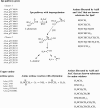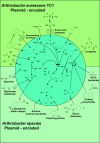Evolution of catabolic pathways: Genomic insights into microbial s-triazine metabolism
- PMID: 17114259
- PMCID: PMC1797303
- DOI: 10.1128/JB.01257-06
Evolution of catabolic pathways: Genomic insights into microbial s-triazine metabolism
Figures




References
-
- Aislabie, J., A. K. Bej, J. Ryburn, N. Lloyd, and A. Wilkins. 2005. Characterization of Arthrobacter nicotinovorans HIM, an atrazine-degrading bacterium, from agricultural soil New Zealand. FEMS Microbiol. Ecol. 52:279-286. - PubMed
-
- Alvey, S., and D. E. Crowley. 1995. Influence of organic amendments on biodegradation of atrazine as a nitrogen source. J. Environ. Qual. 24:1156-1162.
-
- Barriuso, E., and S. Houot. 1996. Rapid mineralization of the s-triazine ring of atrazine in relation to soil management. Soil Biol. Biochem. 28:1341-1348.
-
- Brandsch, R., W. Faller, and K. Schneider. 1986. Plasmid pAO1 of Arthrobacter oxidans encodes 6-hydroxy-d-nicotine oxidase: cloning and expression of the gene in Escherichia coli. Mol. Gen. Genet. 202:96-101. - PubMed
Publication types
MeSH terms
Substances
LinkOut - more resources
Full Text Sources
Other Literature Sources

